Norm time strategy
General
The norm time strategy functionality provides the possibility to determine the norm time for individual transport sections and trip activities in a flexible way.
Functionality - Norm time strategy section vs activity
The norm time strategy page will provide the possibility to define at which level the norm time strategy will apply. The levels that can be defined are "Section" and "Activity". When planning is done in an APS it is adviced to set up the Norm Time Strategy on the section. When planning is done in 3PL Dynamics it is adviced to set up the Norm Time Strategy on the Activity is The impact that the strategy will have throughout the transport process can be found via the process flow below.
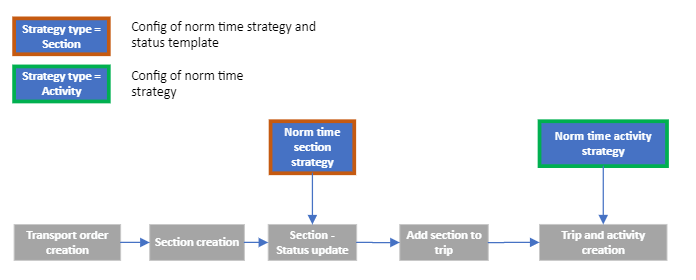
Set up norm time section strategy - GENERAL
The below table will highlight the fields that can be configured via the general tab of the norm time strategy page. The logic of each field will subsequently be described.
| Field | Comment |
|---|---|
| No. | Strategy no. |
| Config type | Section or Activity |
| Description | Norm time strategy description |
| Valid from date | The valid from date specifies from which date the norm time strategy can be determined as valid. The from date itself is included. |
| Valid to date | The valid to date specifies from which date the norm time strategy can be determined as valid. The to date itself is included. |

Set up norm time section strategy - LINES
Before diving into the field logic of the strategy line it is important to understand to which level the strategy lines and detail lines are referring to. As highlighted below, the strategy lines are validating the section as a whole. This means that in terms of for instance quantity validations [qty, load meters, pallet places etc.] the system will run the norm time calculation for the entire section quantity at once. While the norm time lines are validating the section as a whole the detail lines are determening the quantity of each individual goods line. The norm time of each individual goods line will at this level in the end be summed up to determine the norm time for the associated section.

The fields that can be configured via the lines tab of the norm time strategy page can be found below. The associated logic of each field will subsequently be described.
| Field | Comment |
|---|---|
| Priority | Priority of associated line |
| Description | Line description |
| Valid from date | The valid from date specifies from which date the norm time strategy line can be determined as valid. The from date itself is included. |
| Valid to date | The valid to date specifies from which date the norm time strategy line can be determined as valid. The to date itself is included. |
| Table filter | Table filter that can be used to define filter criteria when the line needs to be validated. |
| Criteria function set | Function set that can be used to define function criteria when the line needs to be validated. |
| Criteria function | Criteria function that can be used to define criteria when the line needs to be determine as valid. |
| Quantity calculation | If empty the system will validate the section quantity as input value to calculate the norm time. If other values needs to be used as input the user will have the flexibility to configure a quantity calculation input type or a function set to determine what the input quantity should be |
| Reverse regions | Table filter that can be used to apply filter criteria when the line needs to be validated. |
| Region from code | Link to a region code. When the from address is in this region, this line will executed. |
| Region to code | Link to a [region code(regi.)]. When the to address is in this region, this line will executed |
| Area code | Link to an area code. When the from and to address are in this area, this line will executed. |
| Type | Both, load, or unload. The type determines whether the norm time strategy line/detail line logic needs to update the unload norm time, load norm time, or both. |
| Basic norm time | For the associated norm time line a specific fixed default norm time can be defined. |

Besides the configuration of the above fields it will also be possible to configure "graduated times". The latter will provide flexibility in terms of defining a norm time for a specific quantity range.

Set up norm time section strategy - DETAIL LINES
The fields that can be configured via the detail lines tab of the norm time strategy page follow the same approach as explained earlier via de lines tab fields. The only difference as highlighter earlier is the level at which the quantity calculation will be validated.
Set up norm time section strategy - STATUS TEMPLATE
The section norm time logic will be triggered by means of configuring the functionset via the status template.


Besides the status template it will be important to define the conditions against which the section norm time needs to be written back to. Once specified the below conditions will be updated when the section status is being updated and when the "calculate" section norm time function that is shown above is being triggered.
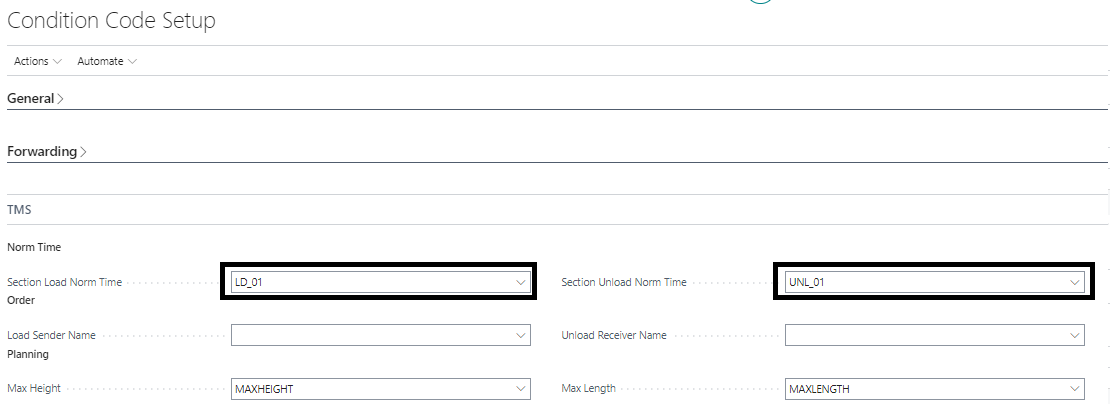
Examples - Norm time section strategy
Scenario 1 - Norm time section strategy - Line level
In the below example the status of a section will be updated from "NEW" to "RELEASED". As part of the released status template the function as earlier has been configured. The section contains four good lines with an associated loading meter quantity of 5 each.

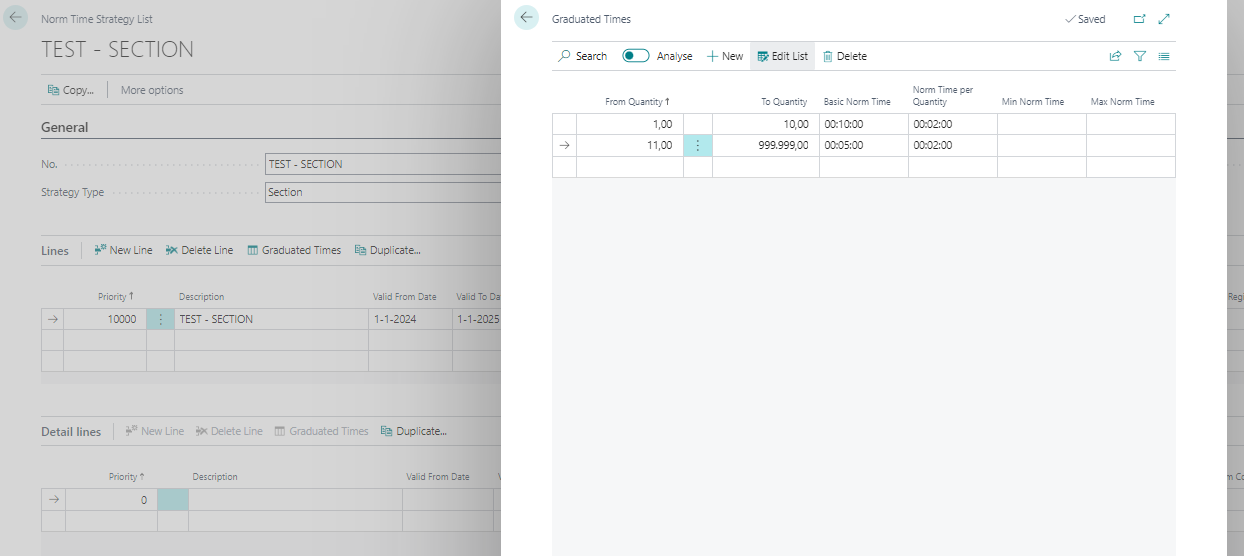

The result of the norm time calculation using the above strategy can be found below [(20*2 min) + 5 min (basic graduated norm time) + 5 min (basic line norm time)].
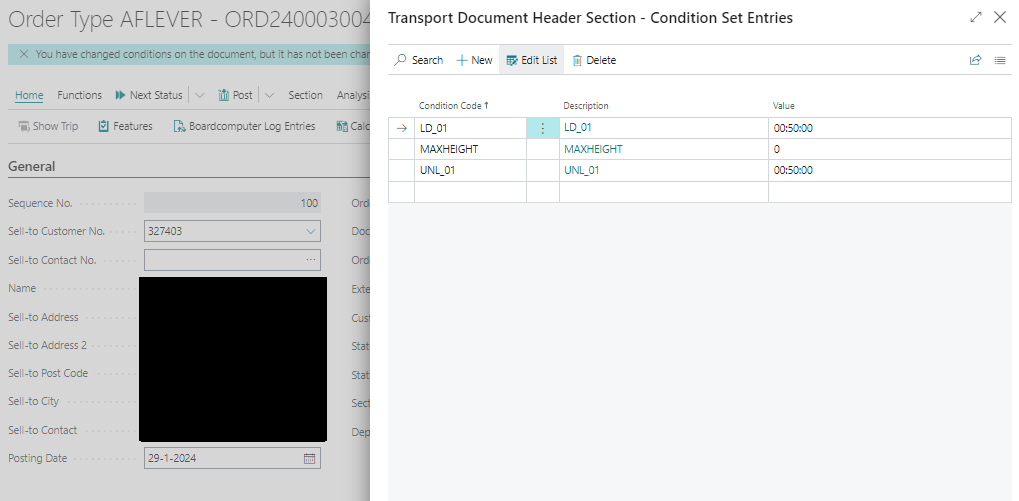
Scenario 2 - Norm time section strategy - Detail line level
In the next example the strategy detail lines have been configured as well. The latter means that the system will loop through each individual good line in order to determine the norm time strategy for the associated section. For the determination of the norm time the section of scenario 1 will be re-used. Note: the quantity calculation approach in the below example is also by loading meters.
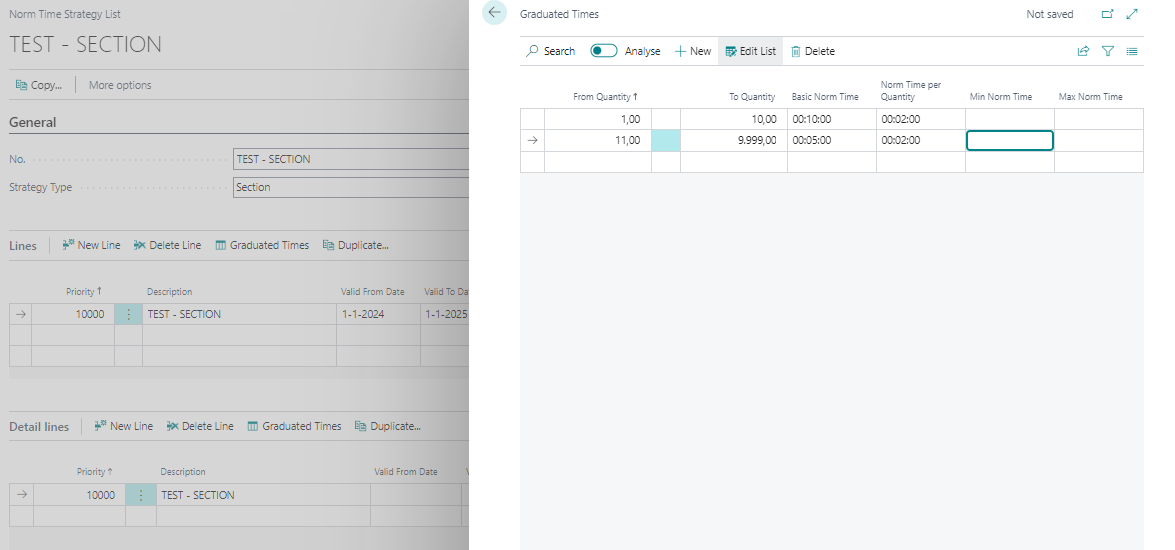
The result of the norm time calculation using the above strategy can be found below [((5*2 min)4) + (410 min - basic graduated norm time) + 5 min (basic line norm time)].
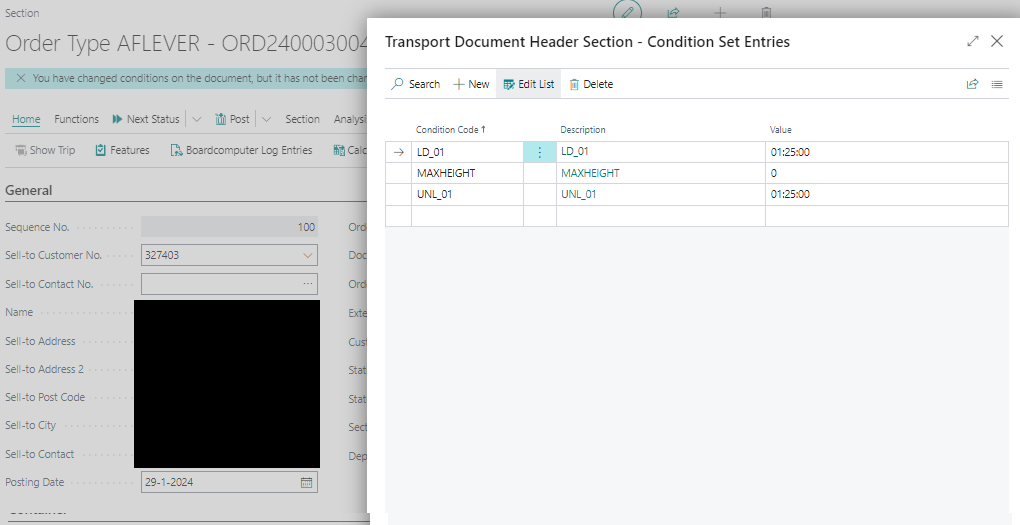
Set up norm time strategy actvity
After the review of the configuration of the section norm time strategy we will now continue with the activity strategy. Except for the switch of the strategy type from "Section" to "Activity" no configuration difference between the section norm time strategy and activity norm time strategy exists. The only thing that is important to understand is that the section strategy will always review individual sections while the activity strategy might review multiple sections in case they belong to the same trip activity. The latter can occur in case multiple sections/orders needs to be loaded or unloaded at the same stop.
Note
- To calculate Norm Times on a Trip the Action: Calculate Trip has to be executed manualy on a Trip or the Function: 11172845-347 has to be included in the status change on Status Template of the Trip.
- The Trip must contain a Plan Department on which the field:* Activity Calculation Type* contains an value not being: Milkrun.
The below example will visualize the earlier mentioned difference. As shown, the section strategy will always validate each individual section. This will be triggered by means of updating the status of the section. Once triggered the associated norm time will be written back against the associated load/unload condition. In the below example this means that the section strategy would have been triggered 8 times by means of updating the status of the associated section. The activity strategy on the other hand will validate all sections that belong to a particular activity/step. Hence, in the below example this means that the activity strategy will calculate 5 norm times [Stop 1-5]. For each stop the associated norm time will be written back against the activity.
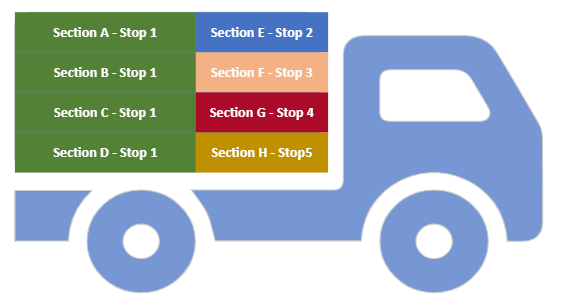
Example - Norm time strategy activity
Scenario 3 - Norm time activity strategy - Line level
The section used as part of scenario 1 and 2 will be a assigned to a trip. The strategy information used as part of scenario 1 will be used as a base for configuring the activity strategy. Hence, the action that will be performed is that the section strategy of scenario 1 will be copied and the strategy type will be updated to "Activity". The norm time that will be assigned to the load and unload stop/activity will subsequently be the same as earlier shown via scenario 1.
